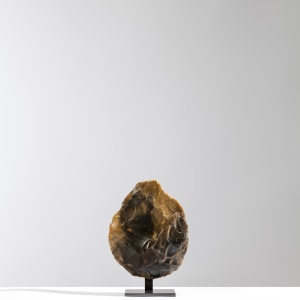Acheulean ovate Handaxe, British, Lower Palaeolithic, c.400,000 BC, found in Kent
Flint
Length: 7.5cm
12186 EL
£ 1,800
Cordate handaxe, knapped from a brown and caramel flint, Wymer type J. No recent losses. The Acheulean industry refers to an early Lower Paleolithic archaeological tradition, distinguished by its characteristic...
Cordate handaxe, knapped from a brown and caramel flint, Wymer type J. No recent losses.
The Acheulean industry refers to an early Lower Paleolithic archaeological tradition, distinguished by its characteristic oval and pear-shaped stone tools such as hand axes and cleavers, crafted by early human species like Homo erectus and Homo heidelbergensis. While the earliest evidence of this technology dates back to around 1.7 million years ago, Acheulean tools in the UK specifically appear from approximately 500,000 years ago. Named after the site of Saint-Acheul in France, this tradition reflects notable cognitive development in early hominins, including the ability to plan and shape tools with purpose. In some regions, the Acheulean persisted until about 130,000 years ago, making it the longest-lasting technological tradition in human history.
The Acheulean industry refers to an early Lower Paleolithic archaeological tradition, distinguished by its characteristic oval and pear-shaped stone tools such as hand axes and cleavers, crafted by early human species like Homo erectus and Homo heidelbergensis. While the earliest evidence of this technology dates back to around 1.7 million years ago, Acheulean tools in the UK specifically appear from approximately 500,000 years ago. Named after the site of Saint-Acheul in France, this tradition reflects notable cognitive development in early hominins, including the ability to plan and shape tools with purpose. In some regions, the Acheulean persisted until about 130,000 years ago, making it the longest-lasting technological tradition in human history.
Provenance
Excavated by David Blake from 1987 to 2013 in the Bishopstone area, Reculver, Kent, UKThis hand axe was amongst a collection of 69 similar handaxes all found on the foreshore between Herne Bay and Reculver, and at an old gravel-pit a mile inland from the coast.
The site at Reculver marks one of the first instances where Palaeolithic tools were first recognised in Britain, in 1860. Since then it has produced hundreds of handaxes, though it wasn't formally excavated until Durham University led a team there in 2023.
Literature
Compare John Wymer, The Lower Palaeolithic Occupation of Britain (Wessex, 1999), Type JSee ibid. p.104 for an image of cliffs where Blake found these handaxes, taken in 1987, the same year Blake started collecting them.



